Nursing Interventions for Older Immigrant Adults in Canada: A Study
VerifiedAdded on 2022/11/29
|16
|3566
|379
Report
AI Summary
This report investigates the healthcare services provided to older immigrants in Canada. It highlights the challenges faced by first-generation immigrant adults, including healthcare access disparities, language barriers, housing issues, and the impact of the Canadian climate. The report reviews the Canadian healthcare system, emphasizing the importance of nursing interventions to address these issues. It discusses specific problems such as the increased workload on nurses, potential for medical errors, and the need for culturally appropriate healthcare services. The study suggests improvements to the healthcare system, focusing on providing better support for the aging immigrant population. The analysis also covers topics like health insurance, housing, and the role of the Canadian government in supporting this demographic.
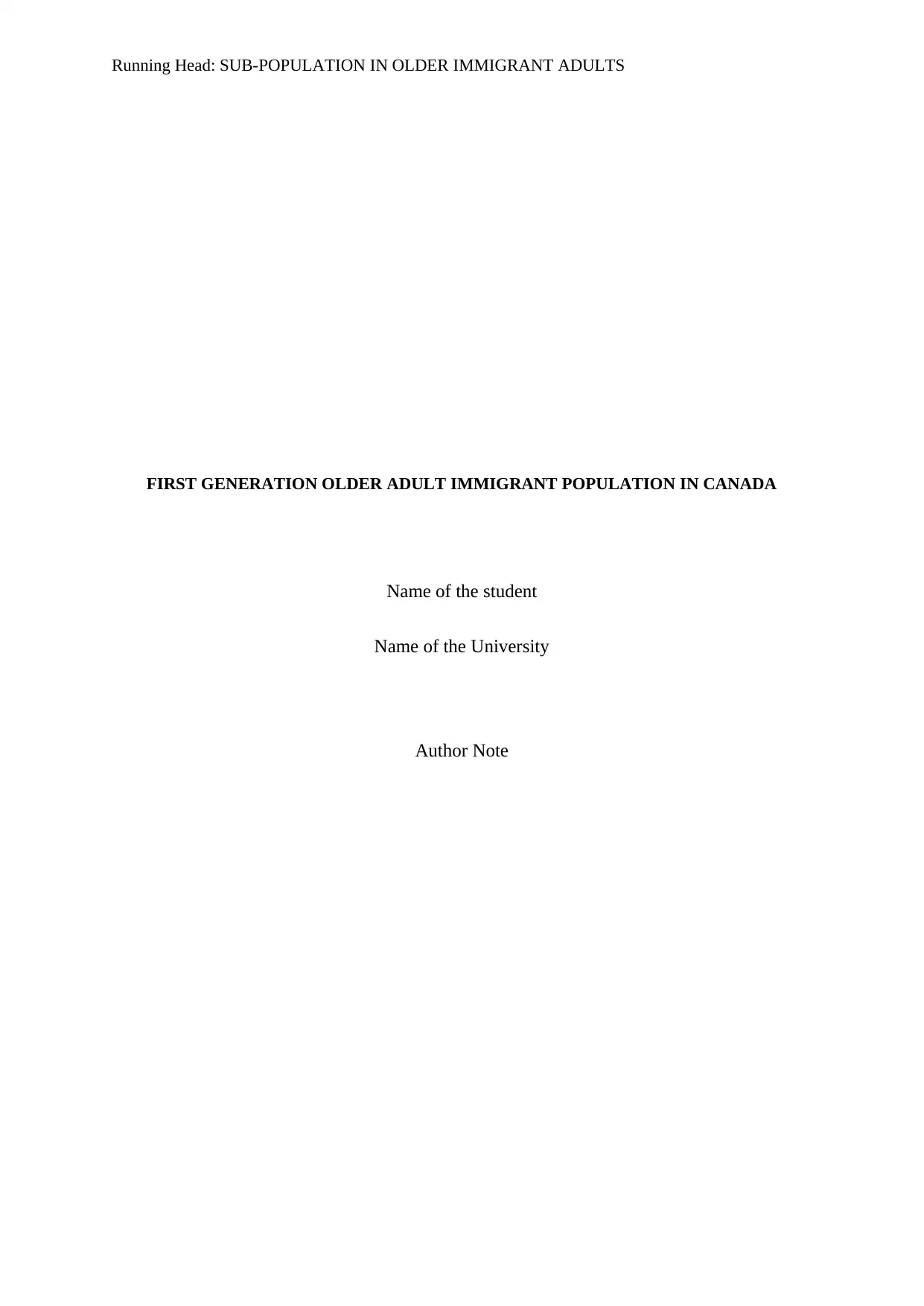
Running Head: SUB-POPULATION IN OLDER IMMIGRANT ADULTS
FIRST GENERATION OLDER ADULT IMMIGRANT POPULATION IN CANADA
Name of the student
Name of the University
Author Note
FIRST GENERATION OLDER ADULT IMMIGRANT POPULATION IN CANADA
Name of the student
Name of the University
Author Note
Paraphrase This Document
Need a fresh take? Get an instant paraphrase of this document with our AI Paraphraser
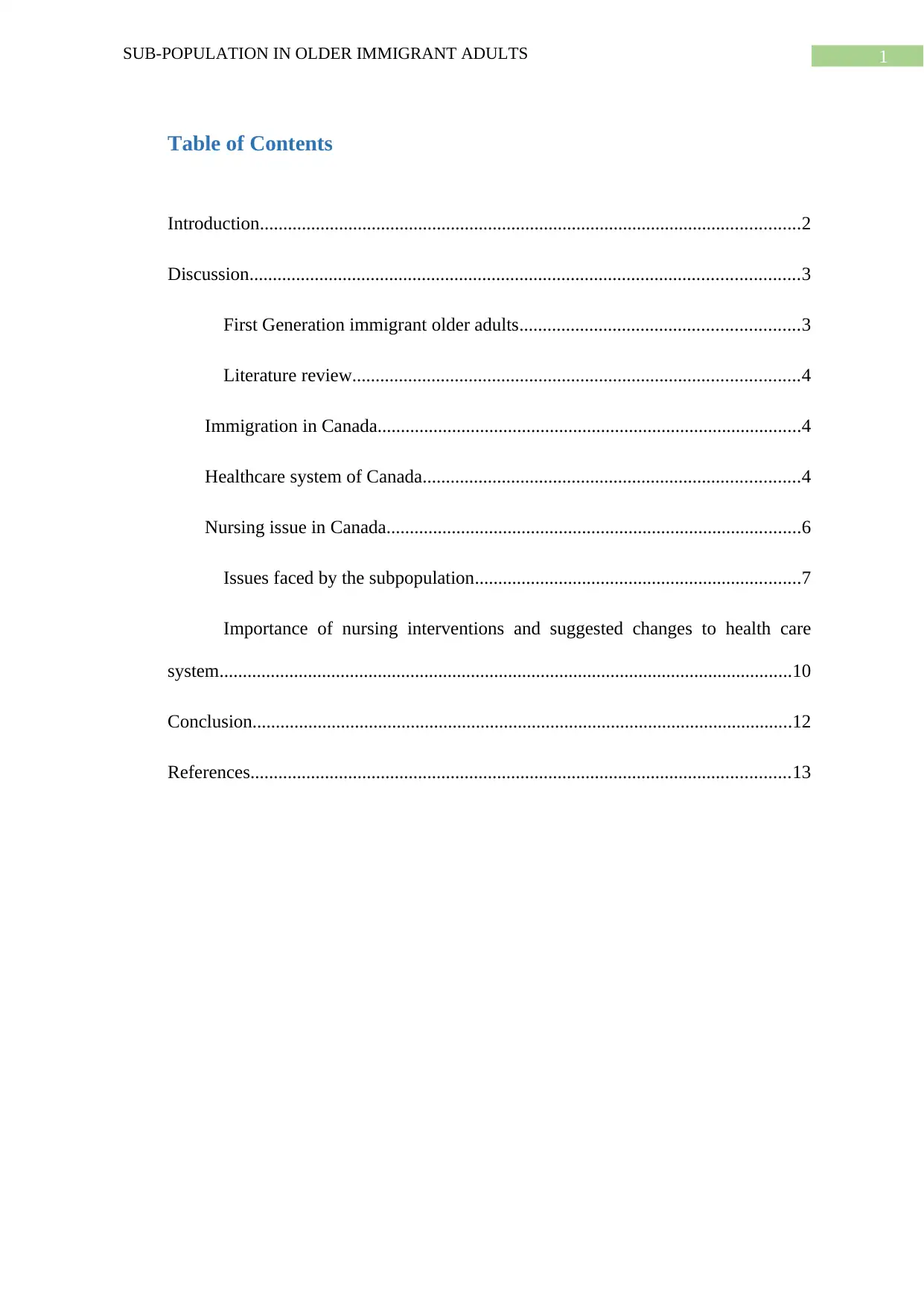
1SUB-POPULATION IN OLDER IMMIGRANT ADULTS
Table of Contents
Introduction....................................................................................................................2
Discussion......................................................................................................................3
First Generation immigrant older adults............................................................3
Literature review................................................................................................4
Immigration in Canada...........................................................................................4
Healthcare system of Canada.................................................................................4
Nursing issue in Canada.........................................................................................6
Issues faced by the subpopulation......................................................................7
Importance of nursing interventions and suggested changes to health care
system...........................................................................................................................10
Conclusion....................................................................................................................12
References....................................................................................................................13
Table of Contents
Introduction....................................................................................................................2
Discussion......................................................................................................................3
First Generation immigrant older adults............................................................3
Literature review................................................................................................4
Immigration in Canada...........................................................................................4
Healthcare system of Canada.................................................................................4
Nursing issue in Canada.........................................................................................6
Issues faced by the subpopulation......................................................................7
Importance of nursing interventions and suggested changes to health care
system...........................................................................................................................10
Conclusion....................................................................................................................12
References....................................................................................................................13
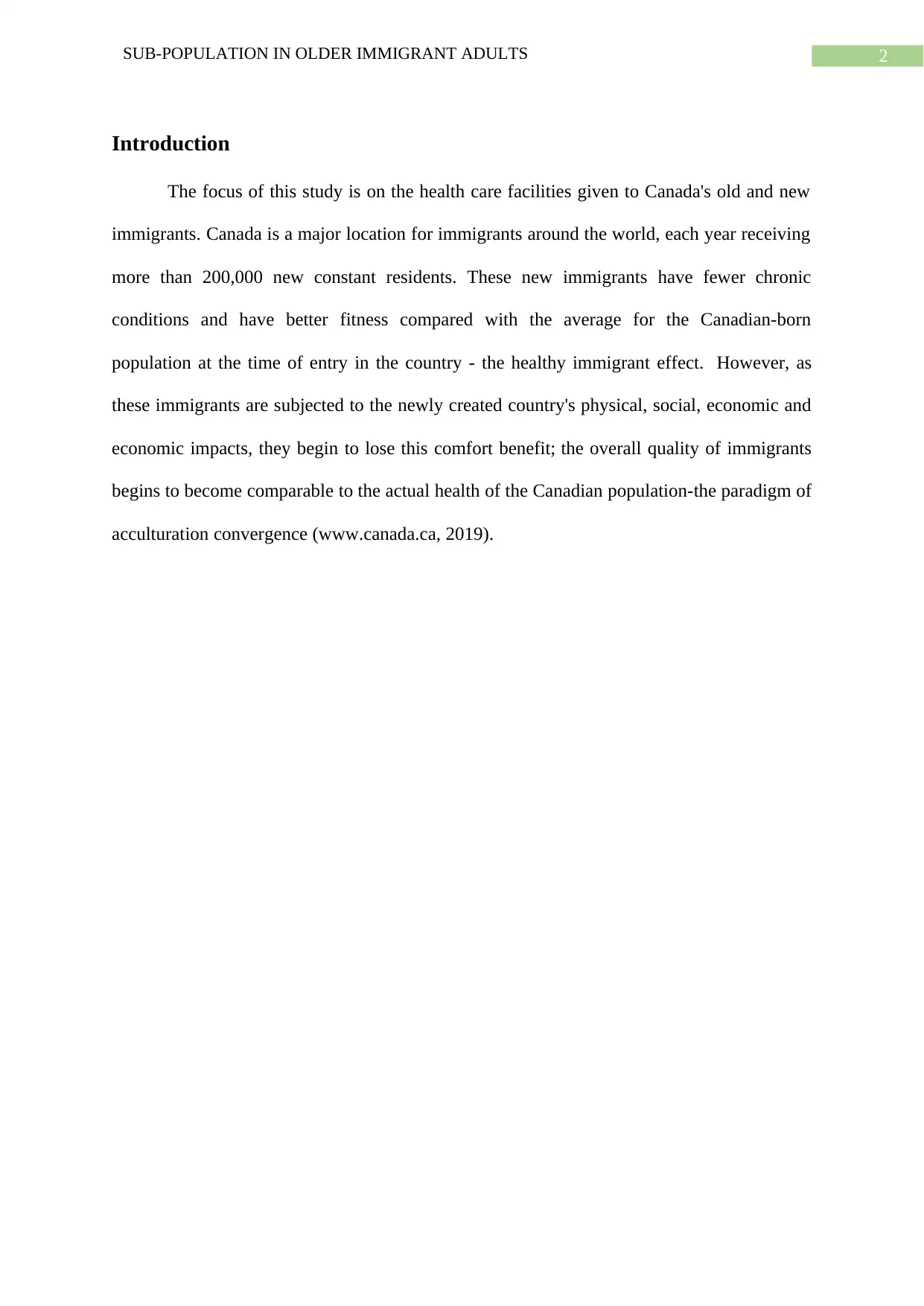
2SUB-POPULATION IN OLDER IMMIGRANT ADULTS
Introduction
The focus of this study is on the health care facilities given to Canada's old and new
immigrants. Canada is a major location for immigrants around the world, each year receiving
more than 200,000 new constant residents. These new immigrants have fewer chronic
conditions and have better fitness compared with the average for the Canadian-born
population at the time of entry in the country - the healthy immigrant effect. However, as
these immigrants are subjected to the newly created country's physical, social, economic and
economic impacts, they begin to lose this comfort benefit; the overall quality of immigrants
begins to become comparable to the actual health of the Canadian population-the paradigm of
acculturation convergence (www.canada.ca, 2019).
Introduction
The focus of this study is on the health care facilities given to Canada's old and new
immigrants. Canada is a major location for immigrants around the world, each year receiving
more than 200,000 new constant residents. These new immigrants have fewer chronic
conditions and have better fitness compared with the average for the Canadian-born
population at the time of entry in the country - the healthy immigrant effect. However, as
these immigrants are subjected to the newly created country's physical, social, economic and
economic impacts, they begin to lose this comfort benefit; the overall quality of immigrants
begins to become comparable to the actual health of the Canadian population-the paradigm of
acculturation convergence (www.canada.ca, 2019).
⊘ This is a preview!⊘
Do you want full access?
Subscribe today to unlock all pages.

Trusted by 1+ million students worldwide
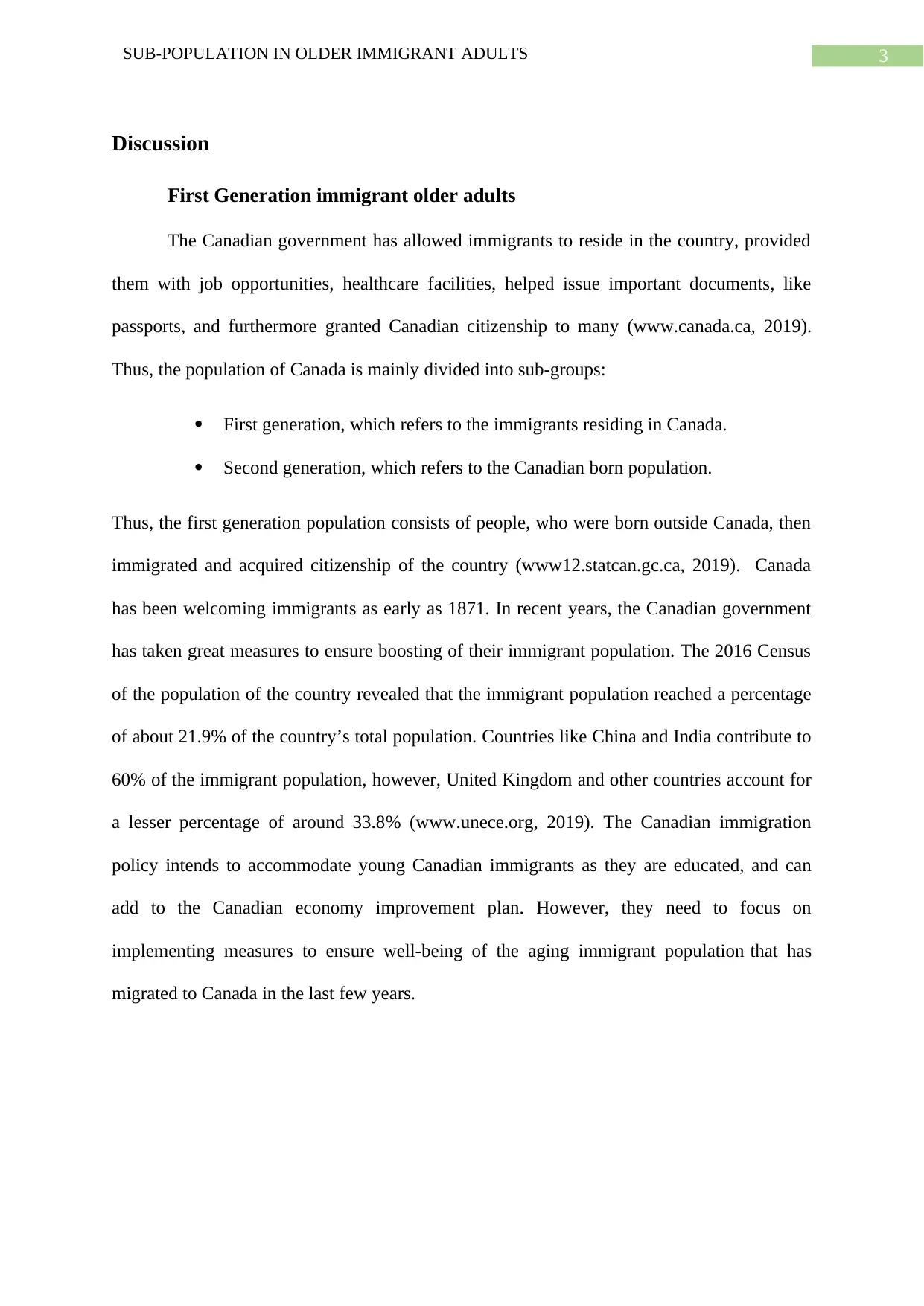
3SUB-POPULATION IN OLDER IMMIGRANT ADULTS
Discussion
First Generation immigrant older adults
The Canadian government has allowed immigrants to reside in the country, provided
them with job opportunities, healthcare facilities, helped issue important documents, like
passports, and furthermore granted Canadian citizenship to many (www.canada.ca, 2019).
Thus, the population of Canada is mainly divided into sub-groups:
First generation, which refers to the immigrants residing in Canada.
Second generation, which refers to the Canadian born population.
Thus, the first generation population consists of people, who were born outside Canada, then
immigrated and acquired citizenship of the country (www12.statcan.gc.ca, 2019). Canada
has been welcoming immigrants as early as 1871. In recent years, the Canadian government
has taken great measures to ensure boosting of their immigrant population. The 2016 Census
of the population of the country revealed that the immigrant population reached a percentage
of about 21.9% of the country’s total population. Countries like China and India contribute to
60% of the immigrant population, however, United Kingdom and other countries account for
a lesser percentage of around 33.8% (www.unece.org, 2019). The Canadian immigration
policy intends to accommodate young Canadian immigrants as they are educated, and can
add to the Canadian economy improvement plan. However, they need to focus on
implementing measures to ensure well-being of the aging immigrant population that has
migrated to Canada in the last few years.
Discussion
First Generation immigrant older adults
The Canadian government has allowed immigrants to reside in the country, provided
them with job opportunities, healthcare facilities, helped issue important documents, like
passports, and furthermore granted Canadian citizenship to many (www.canada.ca, 2019).
Thus, the population of Canada is mainly divided into sub-groups:
First generation, which refers to the immigrants residing in Canada.
Second generation, which refers to the Canadian born population.
Thus, the first generation population consists of people, who were born outside Canada, then
immigrated and acquired citizenship of the country (www12.statcan.gc.ca, 2019). Canada
has been welcoming immigrants as early as 1871. In recent years, the Canadian government
has taken great measures to ensure boosting of their immigrant population. The 2016 Census
of the population of the country revealed that the immigrant population reached a percentage
of about 21.9% of the country’s total population. Countries like China and India contribute to
60% of the immigrant population, however, United Kingdom and other countries account for
a lesser percentage of around 33.8% (www.unece.org, 2019). The Canadian immigration
policy intends to accommodate young Canadian immigrants as they are educated, and can
add to the Canadian economy improvement plan. However, they need to focus on
implementing measures to ensure well-being of the aging immigrant population that has
migrated to Canada in the last few years.
Paraphrase This Document
Need a fresh take? Get an instant paraphrase of this document with our AI Paraphraser
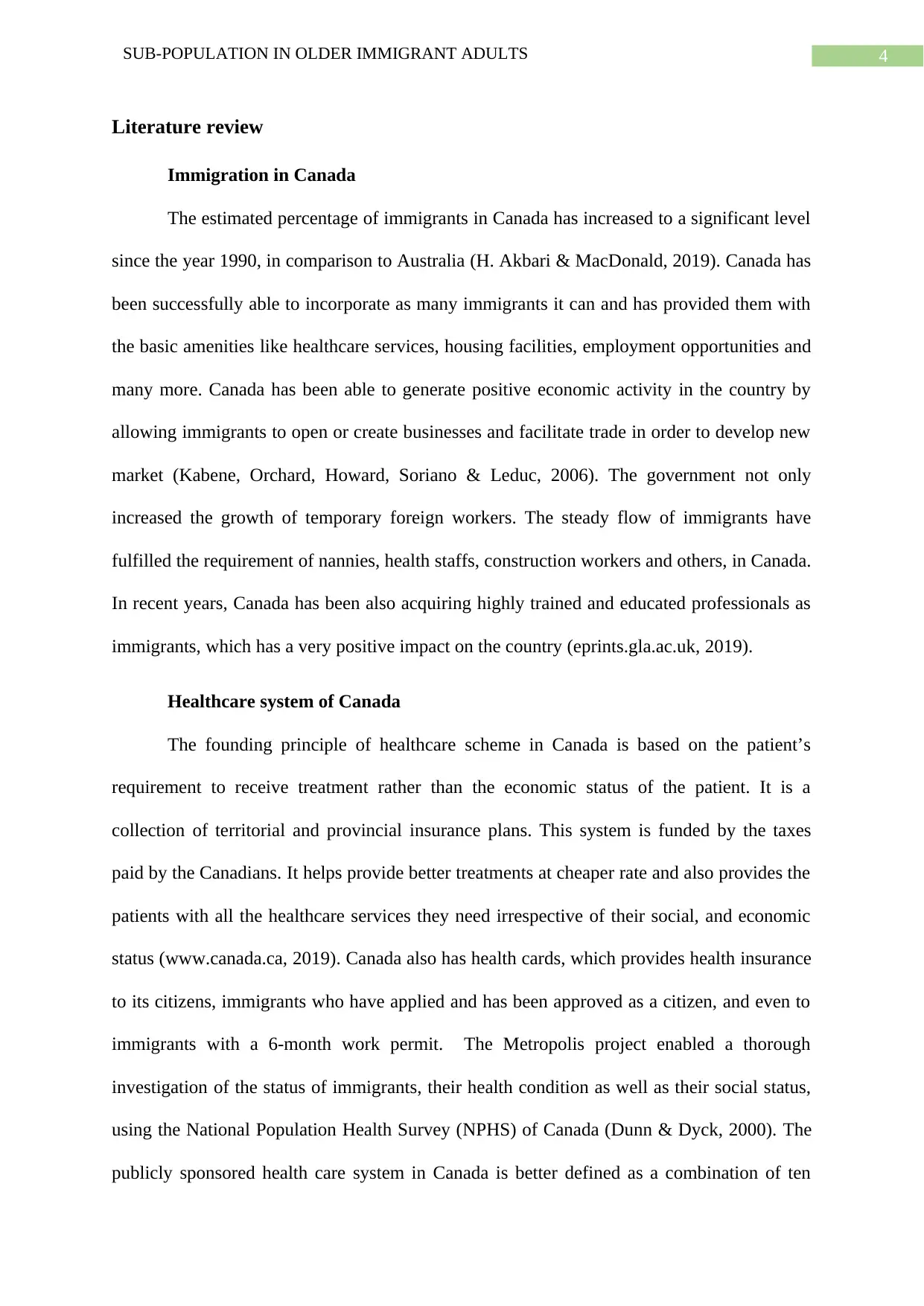
4SUB-POPULATION IN OLDER IMMIGRANT ADULTS
Literature review
Immigration in Canada
The estimated percentage of immigrants in Canada has increased to a significant level
since the year 1990, in comparison to Australia (H. Akbari & MacDonald, 2019). Canada has
been successfully able to incorporate as many immigrants it can and has provided them with
the basic amenities like healthcare services, housing facilities, employment opportunities and
many more. Canada has been able to generate positive economic activity in the country by
allowing immigrants to open or create businesses and facilitate trade in order to develop new
market (Kabene, Orchard, Howard, Soriano & Leduc, 2006). The government not only
increased the growth of temporary foreign workers. The steady flow of immigrants have
fulfilled the requirement of nannies, health staffs, construction workers and others, in Canada.
In recent years, Canada has been also acquiring highly trained and educated professionals as
immigrants, which has a very positive impact on the country (eprints.gla.ac.uk, 2019).
Healthcare system of Canada
The founding principle of healthcare scheme in Canada is based on the patient’s
requirement to receive treatment rather than the economic status of the patient. It is a
collection of territorial and provincial insurance plans. This system is funded by the taxes
paid by the Canadians. It helps provide better treatments at cheaper rate and also provides the
patients with all the healthcare services they need irrespective of their social, and economic
status (www.canada.ca, 2019). Canada also has health cards, which provides health insurance
to its citizens, immigrants who have applied and has been approved as a citizen, and even to
immigrants with a 6-month work permit. The Metropolis project enabled a thorough
investigation of the status of immigrants, their health condition as well as their social status,
using the National Population Health Survey (NPHS) of Canada (Dunn & Dyck, 2000). The
publicly sponsored health care system in Canada is better defined as a combination of ten
Literature review
Immigration in Canada
The estimated percentage of immigrants in Canada has increased to a significant level
since the year 1990, in comparison to Australia (H. Akbari & MacDonald, 2019). Canada has
been successfully able to incorporate as many immigrants it can and has provided them with
the basic amenities like healthcare services, housing facilities, employment opportunities and
many more. Canada has been able to generate positive economic activity in the country by
allowing immigrants to open or create businesses and facilitate trade in order to develop new
market (Kabene, Orchard, Howard, Soriano & Leduc, 2006). The government not only
increased the growth of temporary foreign workers. The steady flow of immigrants have
fulfilled the requirement of nannies, health staffs, construction workers and others, in Canada.
In recent years, Canada has been also acquiring highly trained and educated professionals as
immigrants, which has a very positive impact on the country (eprints.gla.ac.uk, 2019).
Healthcare system of Canada
The founding principle of healthcare scheme in Canada is based on the patient’s
requirement to receive treatment rather than the economic status of the patient. It is a
collection of territorial and provincial insurance plans. This system is funded by the taxes
paid by the Canadians. It helps provide better treatments at cheaper rate and also provides the
patients with all the healthcare services they need irrespective of their social, and economic
status (www.canada.ca, 2019). Canada also has health cards, which provides health insurance
to its citizens, immigrants who have applied and has been approved as a citizen, and even to
immigrants with a 6-month work permit. The Metropolis project enabled a thorough
investigation of the status of immigrants, their health condition as well as their social status,
using the National Population Health Survey (NPHS) of Canada (Dunn & Dyck, 2000). The
publicly sponsored health care system in Canada is better defined as a combination of ten
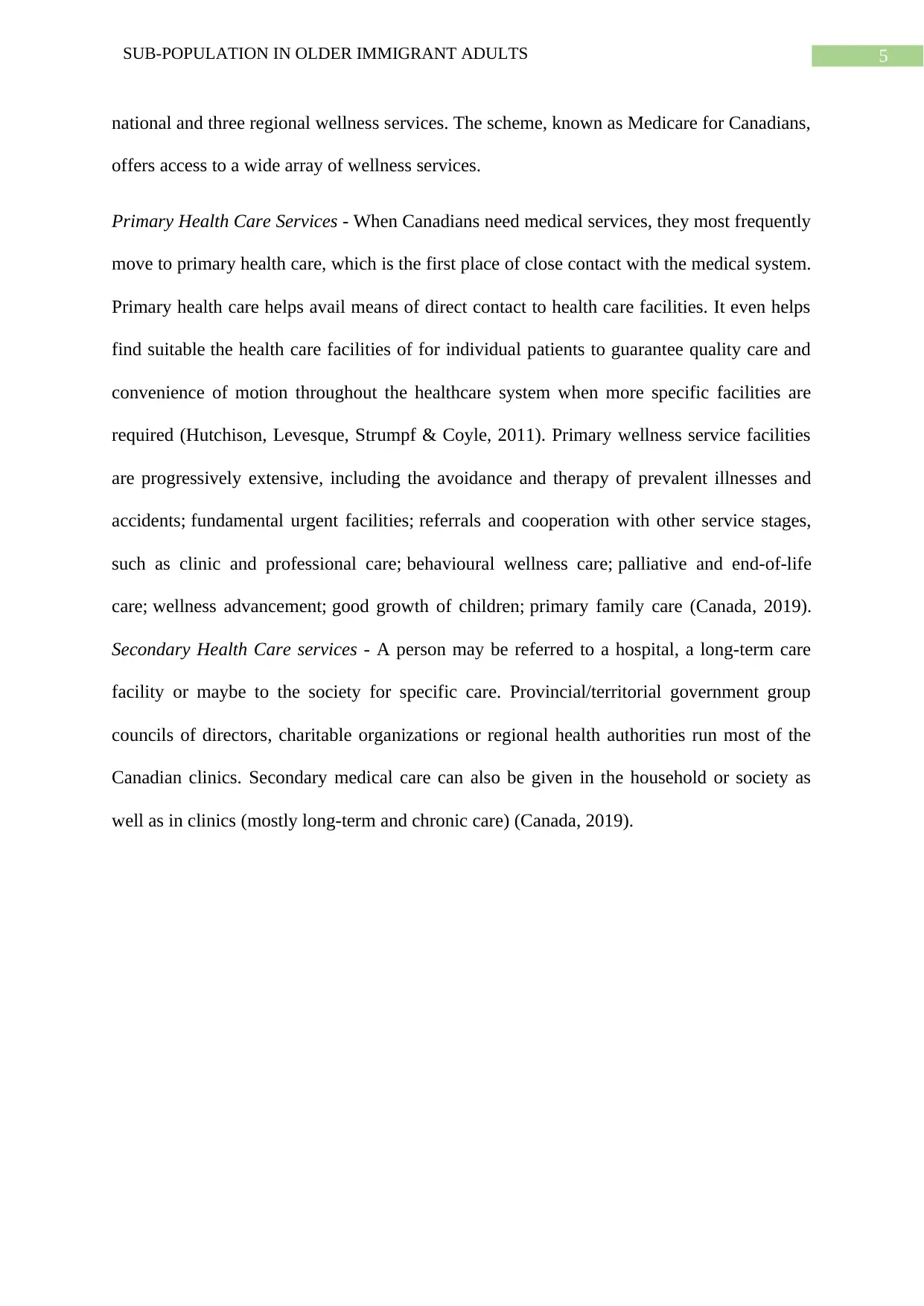
5SUB-POPULATION IN OLDER IMMIGRANT ADULTS
national and three regional wellness services. The scheme, known as Medicare for Canadians,
offers access to a wide array of wellness services.
Primary Health Care Services - When Canadians need medical services, they most frequently
move to primary health care, which is the first place of close contact with the medical system.
Primary health care helps avail means of direct contact to health care facilities. It even helps
find suitable the health care facilities of for individual patients to guarantee quality care and
convenience of motion throughout the healthcare system when more specific facilities are
required (Hutchison, Levesque, Strumpf & Coyle, 2011). Primary wellness service facilities
are progressively extensive, including the avoidance and therapy of prevalent illnesses and
accidents; fundamental urgent facilities; referrals and cooperation with other service stages,
such as clinic and professional care; behavioural wellness care; palliative and end-of-life
care; wellness advancement; good growth of children; primary family care (Canada, 2019).
Secondary Health Care services - A person may be referred to a hospital, a long-term care
facility or maybe to the society for specific care. Provincial/territorial government group
councils of directors, charitable organizations or regional health authorities run most of the
Canadian clinics. Secondary medical care can also be given in the household or society as
well as in clinics (mostly long-term and chronic care) (Canada, 2019).
national and three regional wellness services. The scheme, known as Medicare for Canadians,
offers access to a wide array of wellness services.
Primary Health Care Services - When Canadians need medical services, they most frequently
move to primary health care, which is the first place of close contact with the medical system.
Primary health care helps avail means of direct contact to health care facilities. It even helps
find suitable the health care facilities of for individual patients to guarantee quality care and
convenience of motion throughout the healthcare system when more specific facilities are
required (Hutchison, Levesque, Strumpf & Coyle, 2011). Primary wellness service facilities
are progressively extensive, including the avoidance and therapy of prevalent illnesses and
accidents; fundamental urgent facilities; referrals and cooperation with other service stages,
such as clinic and professional care; behavioural wellness care; palliative and end-of-life
care; wellness advancement; good growth of children; primary family care (Canada, 2019).
Secondary Health Care services - A person may be referred to a hospital, a long-term care
facility or maybe to the society for specific care. Provincial/territorial government group
councils of directors, charitable organizations or regional health authorities run most of the
Canadian clinics. Secondary medical care can also be given in the household or society as
well as in clinics (mostly long-term and chronic care) (Canada, 2019).
⊘ This is a preview!⊘
Do you want full access?
Subscribe today to unlock all pages.

Trusted by 1+ million students worldwide
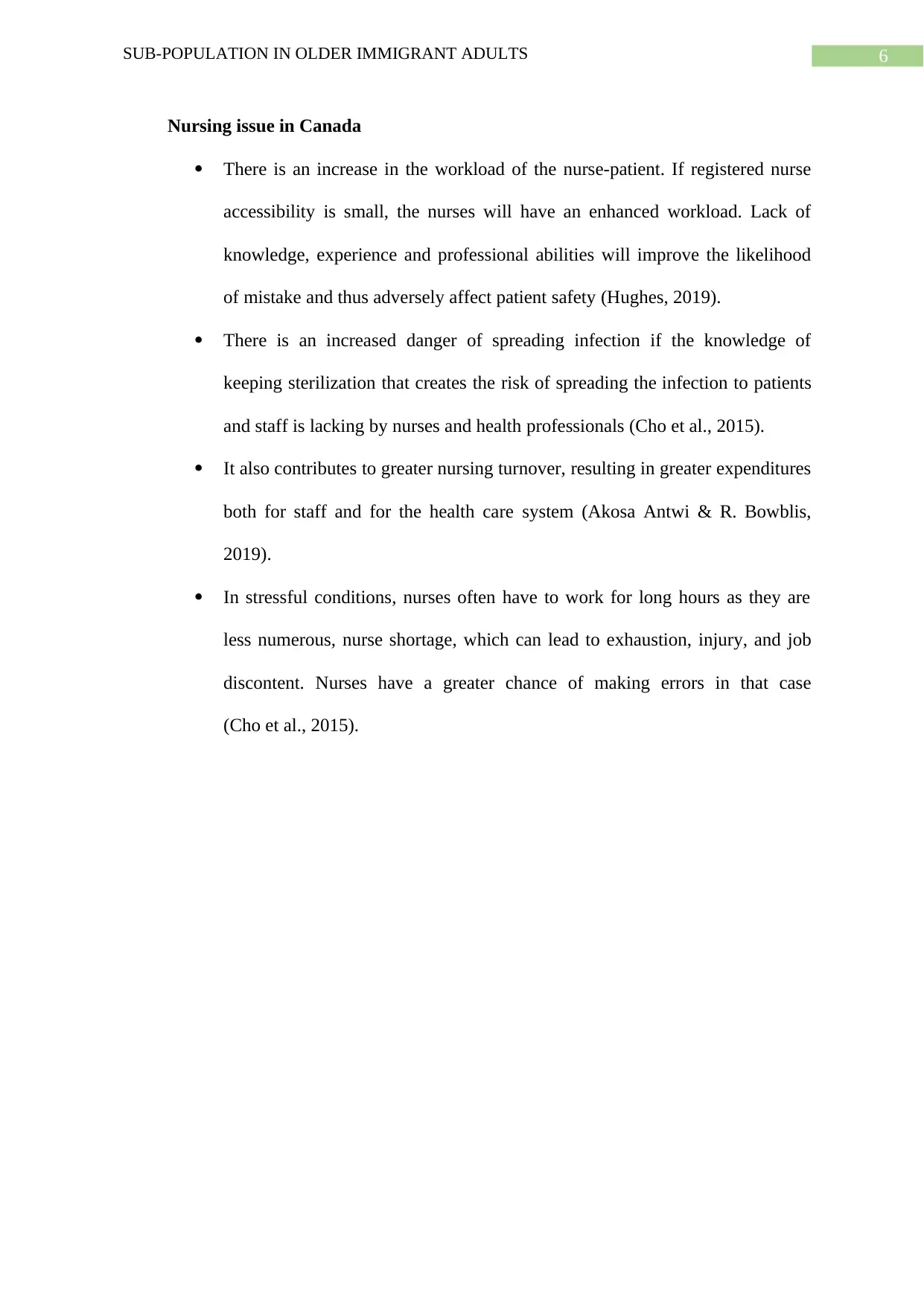
6SUB-POPULATION IN OLDER IMMIGRANT ADULTS
Nursing issue in Canada
There is an increase in the workload of the nurse-patient. If registered nurse
accessibility is small, the nurses will have an enhanced workload. Lack of
knowledge, experience and professional abilities will improve the likelihood
of mistake and thus adversely affect patient safety (Hughes, 2019).
There is an increased danger of spreading infection if the knowledge of
keeping sterilization that creates the risk of spreading the infection to patients
and staff is lacking by nurses and health professionals (Cho et al., 2015).
It also contributes to greater nursing turnover, resulting in greater expenditures
both for staff and for the health care system (Akosa Antwi & R. Bowblis,
2019).
In stressful conditions, nurses often have to work for long hours as they are
less numerous, nurse shortage, which can lead to exhaustion, injury, and job
discontent. Nurses have a greater chance of making errors in that case
(Cho et al., 2015).
Nursing issue in Canada
There is an increase in the workload of the nurse-patient. If registered nurse
accessibility is small, the nurses will have an enhanced workload. Lack of
knowledge, experience and professional abilities will improve the likelihood
of mistake and thus adversely affect patient safety (Hughes, 2019).
There is an increased danger of spreading infection if the knowledge of
keeping sterilization that creates the risk of spreading the infection to patients
and staff is lacking by nurses and health professionals (Cho et al., 2015).
It also contributes to greater nursing turnover, resulting in greater expenditures
both for staff and for the health care system (Akosa Antwi & R. Bowblis,
2019).
In stressful conditions, nurses often have to work for long hours as they are
less numerous, nurse shortage, which can lead to exhaustion, injury, and job
discontent. Nurses have a greater chance of making errors in that case
(Cho et al., 2015).
Paraphrase This Document
Need a fresh take? Get an instant paraphrase of this document with our AI Paraphraser
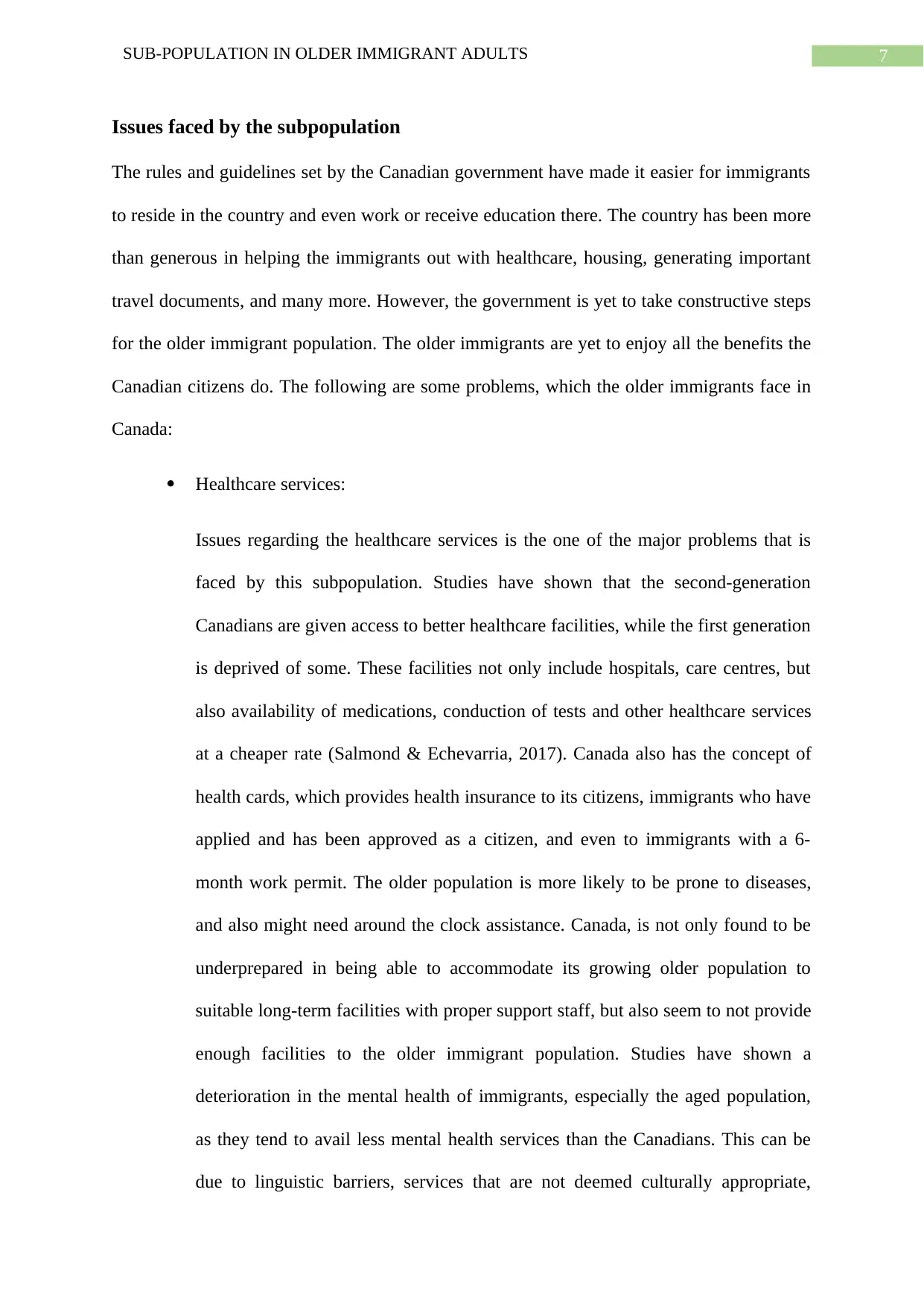
7SUB-POPULATION IN OLDER IMMIGRANT ADULTS
Issues faced by the subpopulation
The rules and guidelines set by the Canadian government have made it easier for immigrants
to reside in the country and even work or receive education there. The country has been more
than generous in helping the immigrants out with healthcare, housing, generating important
travel documents, and many more. However, the government is yet to take constructive steps
for the older immigrant population. The older immigrants are yet to enjoy all the benefits the
Canadian citizens do. The following are some problems, which the older immigrants face in
Canada:
Healthcare services:
Issues regarding the healthcare services is the one of the major problems that is
faced by this subpopulation. Studies have shown that the second-generation
Canadians are given access to better healthcare facilities, while the first generation
is deprived of some. These facilities not only include hospitals, care centres, but
also availability of medications, conduction of tests and other healthcare services
at a cheaper rate (Salmond & Echevarria, 2017). Canada also has the concept of
health cards, which provides health insurance to its citizens, immigrants who have
applied and has been approved as a citizen, and even to immigrants with a 6-
month work permit. The older population is more likely to be prone to diseases,
and also might need around the clock assistance. Canada, is not only found to be
underprepared in being able to accommodate its growing older population to
suitable long-term facilities with proper support staff, but also seem to not provide
enough facilities to the older immigrant population. Studies have shown a
deterioration in the mental health of immigrants, especially the aged population,
as they tend to avail less mental health services than the Canadians. This can be
due to linguistic barriers, services that are not deemed culturally appropriate,
Issues faced by the subpopulation
The rules and guidelines set by the Canadian government have made it easier for immigrants
to reside in the country and even work or receive education there. The country has been more
than generous in helping the immigrants out with healthcare, housing, generating important
travel documents, and many more. However, the government is yet to take constructive steps
for the older immigrant population. The older immigrants are yet to enjoy all the benefits the
Canadian citizens do. The following are some problems, which the older immigrants face in
Canada:
Healthcare services:
Issues regarding the healthcare services is the one of the major problems that is
faced by this subpopulation. Studies have shown that the second-generation
Canadians are given access to better healthcare facilities, while the first generation
is deprived of some. These facilities not only include hospitals, care centres, but
also availability of medications, conduction of tests and other healthcare services
at a cheaper rate (Salmond & Echevarria, 2017). Canada also has the concept of
health cards, which provides health insurance to its citizens, immigrants who have
applied and has been approved as a citizen, and even to immigrants with a 6-
month work permit. The older population is more likely to be prone to diseases,
and also might need around the clock assistance. Canada, is not only found to be
underprepared in being able to accommodate its growing older population to
suitable long-term facilities with proper support staff, but also seem to not provide
enough facilities to the older immigrant population. Studies have shown a
deterioration in the mental health of immigrants, especially the aged population,
as they tend to avail less mental health services than the Canadians. This can be
due to linguistic barriers, services that are not deemed culturally appropriate,
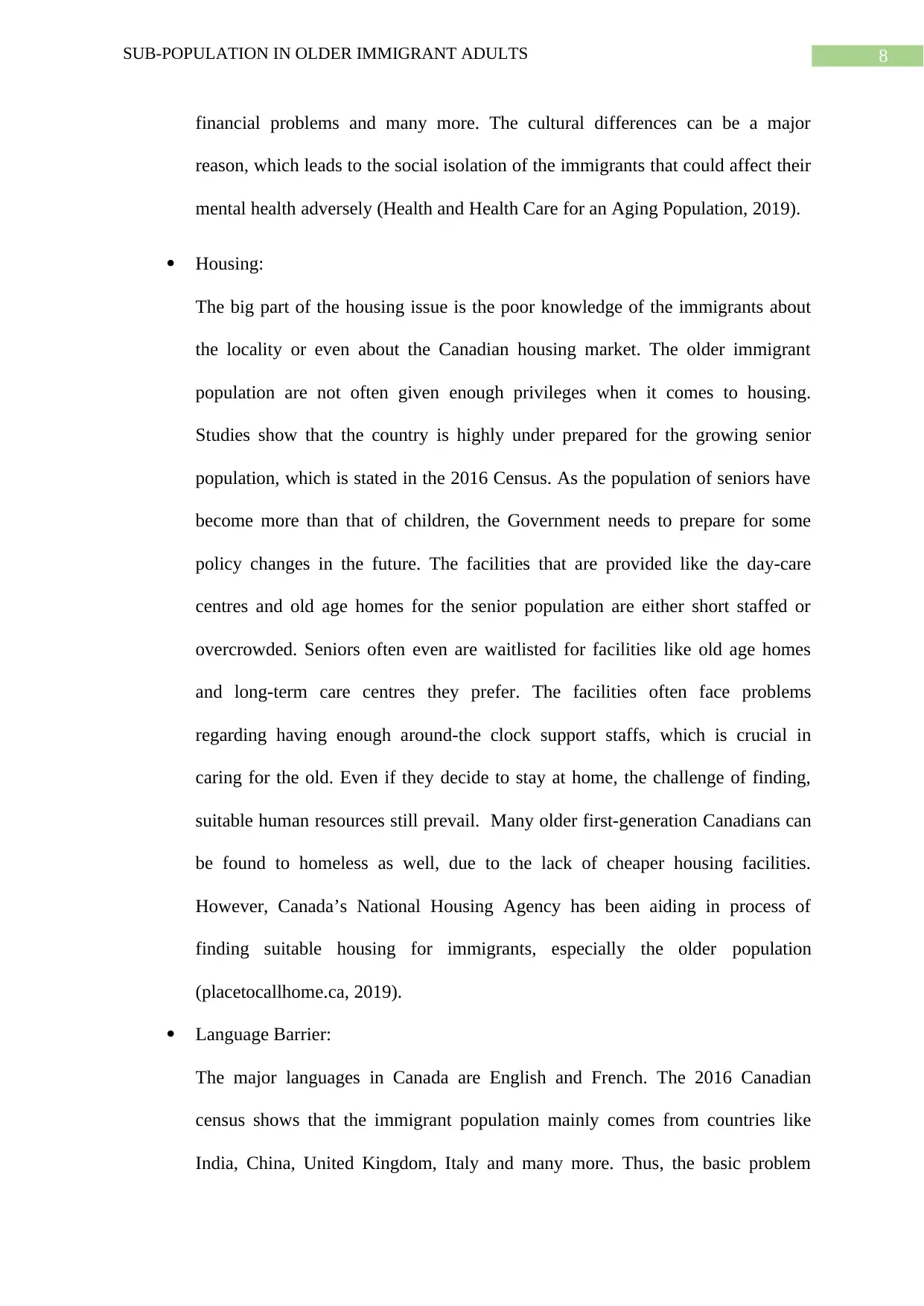
8SUB-POPULATION IN OLDER IMMIGRANT ADULTS
financial problems and many more. The cultural differences can be a major
reason, which leads to the social isolation of the immigrants that could affect their
mental health adversely (Health and Health Care for an Aging Population, 2019).
Housing:
The big part of the housing issue is the poor knowledge of the immigrants about
the locality or even about the Canadian housing market. The older immigrant
population are not often given enough privileges when it comes to housing.
Studies show that the country is highly under prepared for the growing senior
population, which is stated in the 2016 Census. As the population of seniors have
become more than that of children, the Government needs to prepare for some
policy changes in the future. The facilities that are provided like the day-care
centres and old age homes for the senior population are either short staffed or
overcrowded. Seniors often even are waitlisted for facilities like old age homes
and long-term care centres they prefer. The facilities often face problems
regarding having enough around-the clock support staffs, which is crucial in
caring for the old. Even if they decide to stay at home, the challenge of finding,
suitable human resources still prevail. Many older first-generation Canadians can
be found to homeless as well, due to the lack of cheaper housing facilities.
However, Canada’s National Housing Agency has been aiding in process of
finding suitable housing for immigrants, especially the older population
(placetocallhome.ca, 2019).
Language Barrier:
The major languages in Canada are English and French. The 2016 Canadian
census shows that the immigrant population mainly comes from countries like
India, China, United Kingdom, Italy and many more. Thus, the basic problem
financial problems and many more. The cultural differences can be a major
reason, which leads to the social isolation of the immigrants that could affect their
mental health adversely (Health and Health Care for an Aging Population, 2019).
Housing:
The big part of the housing issue is the poor knowledge of the immigrants about
the locality or even about the Canadian housing market. The older immigrant
population are not often given enough privileges when it comes to housing.
Studies show that the country is highly under prepared for the growing senior
population, which is stated in the 2016 Census. As the population of seniors have
become more than that of children, the Government needs to prepare for some
policy changes in the future. The facilities that are provided like the day-care
centres and old age homes for the senior population are either short staffed or
overcrowded. Seniors often even are waitlisted for facilities like old age homes
and long-term care centres they prefer. The facilities often face problems
regarding having enough around-the clock support staffs, which is crucial in
caring for the old. Even if they decide to stay at home, the challenge of finding,
suitable human resources still prevail. Many older first-generation Canadians can
be found to homeless as well, due to the lack of cheaper housing facilities.
However, Canada’s National Housing Agency has been aiding in process of
finding suitable housing for immigrants, especially the older population
(placetocallhome.ca, 2019).
Language Barrier:
The major languages in Canada are English and French. The 2016 Canadian
census shows that the immigrant population mainly comes from countries like
India, China, United Kingdom, Italy and many more. Thus, the basic problem
⊘ This is a preview!⊘
Do you want full access?
Subscribe today to unlock all pages.

Trusted by 1+ million students worldwide
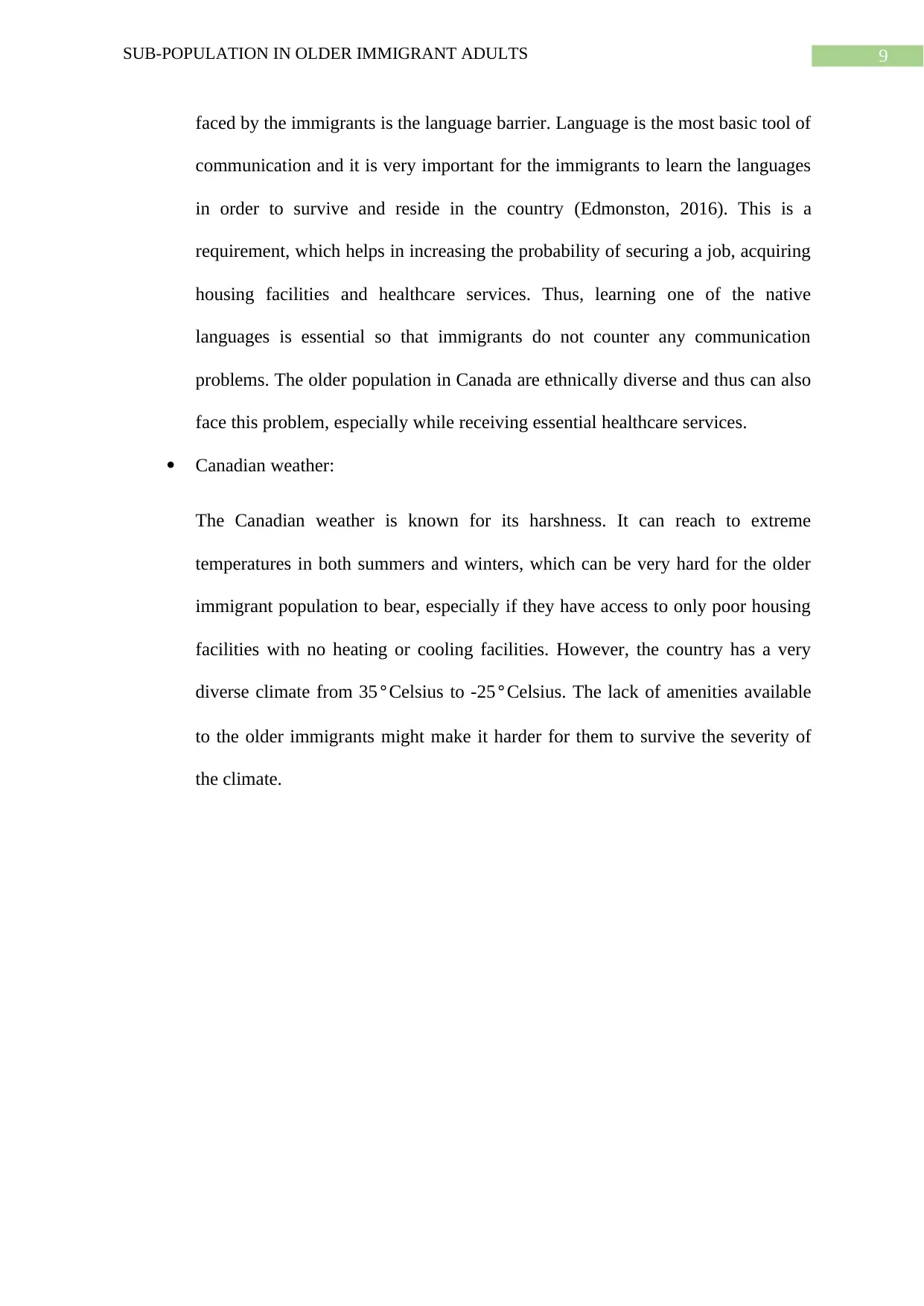
9SUB-POPULATION IN OLDER IMMIGRANT ADULTS
faced by the immigrants is the language barrier. Language is the most basic tool of
communication and it is very important for the immigrants to learn the languages
in order to survive and reside in the country (Edmonston, 2016). This is a
requirement, which helps in increasing the probability of securing a job, acquiring
housing facilities and healthcare services. Thus, learning one of the native
languages is essential so that immigrants do not counter any communication
problems. The older population in Canada are ethnically diverse and thus can also
face this problem, especially while receiving essential healthcare services.
Canadian weather:
The Canadian weather is known for its harshness. It can reach to extreme
temperatures in both summers and winters, which can be very hard for the older
immigrant population to bear, especially if they have access to only poor housing
facilities with no heating or cooling facilities. However, the country has a very
diverse climate from 35°Celsius to -25°Celsius. The lack of amenities available
to the older immigrants might make it harder for them to survive the severity of
the climate.
faced by the immigrants is the language barrier. Language is the most basic tool of
communication and it is very important for the immigrants to learn the languages
in order to survive and reside in the country (Edmonston, 2016). This is a
requirement, which helps in increasing the probability of securing a job, acquiring
housing facilities and healthcare services. Thus, learning one of the native
languages is essential so that immigrants do not counter any communication
problems. The older population in Canada are ethnically diverse and thus can also
face this problem, especially while receiving essential healthcare services.
Canadian weather:
The Canadian weather is known for its harshness. It can reach to extreme
temperatures in both summers and winters, which can be very hard for the older
immigrant population to bear, especially if they have access to only poor housing
facilities with no heating or cooling facilities. However, the country has a very
diverse climate from 35°Celsius to -25°Celsius. The lack of amenities available
to the older immigrants might make it harder for them to survive the severity of
the climate.
Paraphrase This Document
Need a fresh take? Get an instant paraphrase of this document with our AI Paraphraser
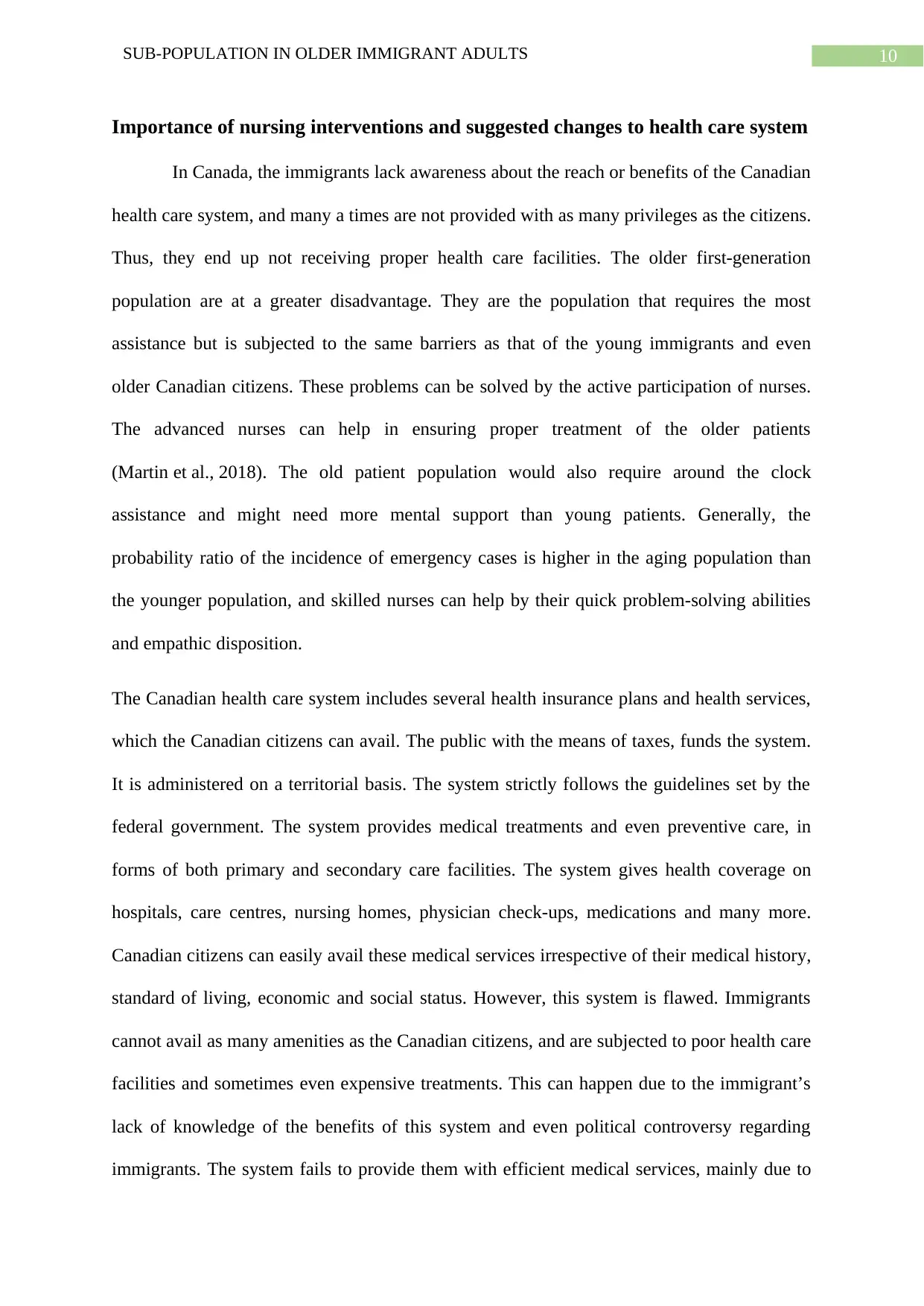
10SUB-POPULATION IN OLDER IMMIGRANT ADULTS
Importance of nursing interventions and suggested changes to health care system
In Canada, the immigrants lack awareness about the reach or benefits of the Canadian
health care system, and many a times are not provided with as many privileges as the citizens.
Thus, they end up not receiving proper health care facilities. The older first-generation
population are at a greater disadvantage. They are the population that requires the most
assistance but is subjected to the same barriers as that of the young immigrants and even
older Canadian citizens. These problems can be solved by the active participation of nurses.
The advanced nurses can help in ensuring proper treatment of the older patients
(Martin et al., 2018). The old patient population would also require around the clock
assistance and might need more mental support than young patients. Generally, the
probability ratio of the incidence of emergency cases is higher in the aging population than
the younger population, and skilled nurses can help by their quick problem-solving abilities
and empathic disposition.
The Canadian health care system includes several health insurance plans and health services,
which the Canadian citizens can avail. The public with the means of taxes, funds the system.
It is administered on a territorial basis. The system strictly follows the guidelines set by the
federal government. The system provides medical treatments and even preventive care, in
forms of both primary and secondary care facilities. The system gives health coverage on
hospitals, care centres, nursing homes, physician check-ups, medications and many more.
Canadian citizens can easily avail these medical services irrespective of their medical history,
standard of living, economic and social status. However, this system is flawed. Immigrants
cannot avail as many amenities as the Canadian citizens, and are subjected to poor health care
facilities and sometimes even expensive treatments. This can happen due to the immigrant’s
lack of knowledge of the benefits of this system and even political controversy regarding
immigrants. The system fails to provide them with efficient medical services, mainly due to
Importance of nursing interventions and suggested changes to health care system
In Canada, the immigrants lack awareness about the reach or benefits of the Canadian
health care system, and many a times are not provided with as many privileges as the citizens.
Thus, they end up not receiving proper health care facilities. The older first-generation
population are at a greater disadvantage. They are the population that requires the most
assistance but is subjected to the same barriers as that of the young immigrants and even
older Canadian citizens. These problems can be solved by the active participation of nurses.
The advanced nurses can help in ensuring proper treatment of the older patients
(Martin et al., 2018). The old patient population would also require around the clock
assistance and might need more mental support than young patients. Generally, the
probability ratio of the incidence of emergency cases is higher in the aging population than
the younger population, and skilled nurses can help by their quick problem-solving abilities
and empathic disposition.
The Canadian health care system includes several health insurance plans and health services,
which the Canadian citizens can avail. The public with the means of taxes, funds the system.
It is administered on a territorial basis. The system strictly follows the guidelines set by the
federal government. The system provides medical treatments and even preventive care, in
forms of both primary and secondary care facilities. The system gives health coverage on
hospitals, care centres, nursing homes, physician check-ups, medications and many more.
Canadian citizens can easily avail these medical services irrespective of their medical history,
standard of living, economic and social status. However, this system is flawed. Immigrants
cannot avail as many amenities as the Canadian citizens, and are subjected to poor health care
facilities and sometimes even expensive treatments. This can happen due to the immigrant’s
lack of knowledge of the benefits of this system and even political controversy regarding
immigrants. The system fails to provide them with efficient medical services, mainly due to
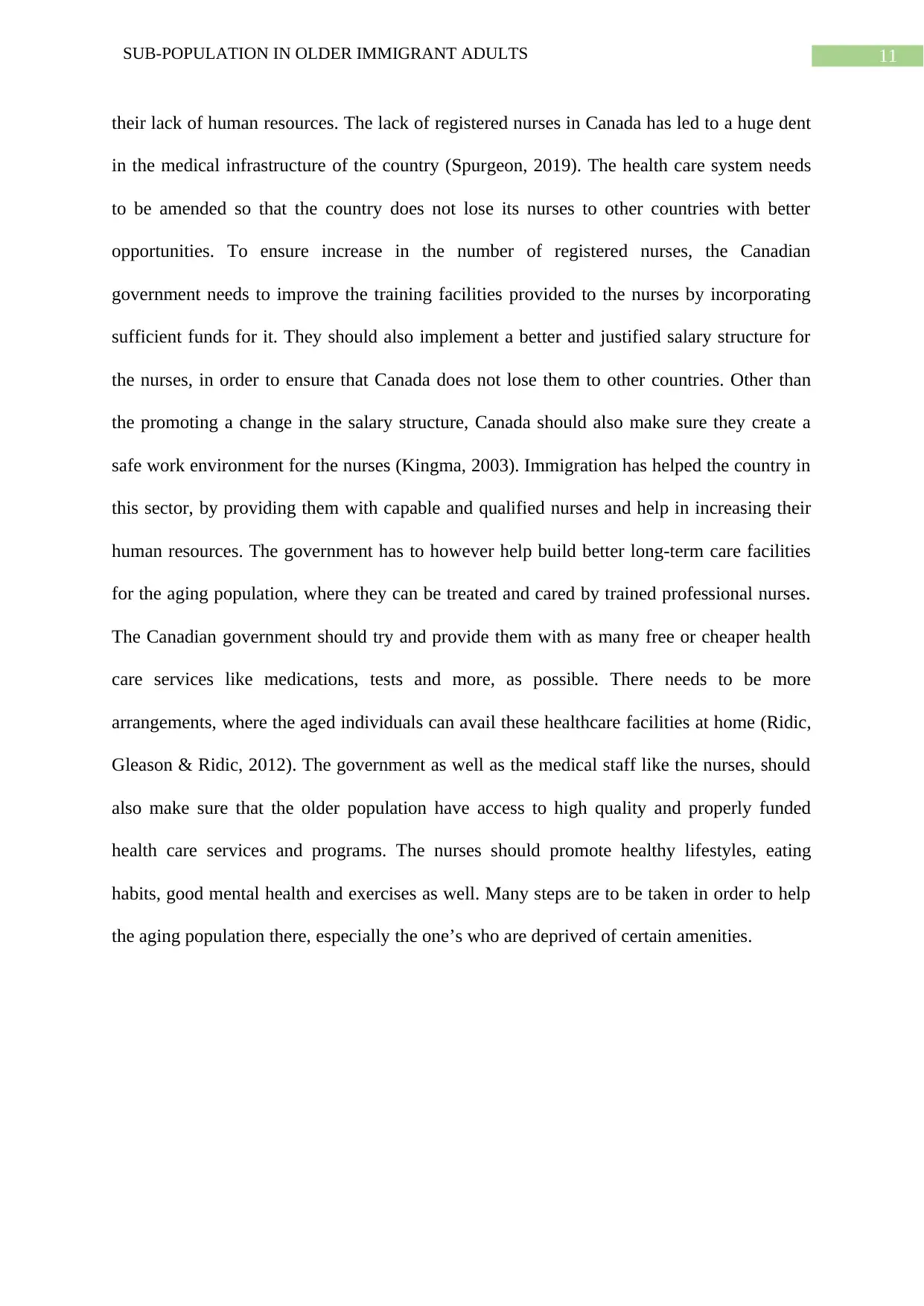
11SUB-POPULATION IN OLDER IMMIGRANT ADULTS
their lack of human resources. The lack of registered nurses in Canada has led to a huge dent
in the medical infrastructure of the country (Spurgeon, 2019). The health care system needs
to be amended so that the country does not lose its nurses to other countries with better
opportunities. To ensure increase in the number of registered nurses, the Canadian
government needs to improve the training facilities provided to the nurses by incorporating
sufficient funds for it. They should also implement a better and justified salary structure for
the nurses, in order to ensure that Canada does not lose them to other countries. Other than
the promoting a change in the salary structure, Canada should also make sure they create a
safe work environment for the nurses (Kingma, 2003). Immigration has helped the country in
this sector, by providing them with capable and qualified nurses and help in increasing their
human resources. The government has to however help build better long-term care facilities
for the aging population, where they can be treated and cared by trained professional nurses.
The Canadian government should try and provide them with as many free or cheaper health
care services like medications, tests and more, as possible. There needs to be more
arrangements, where the aged individuals can avail these healthcare facilities at home (Ridic,
Gleason & Ridic, 2012). The government as well as the medical staff like the nurses, should
also make sure that the older population have access to high quality and properly funded
health care services and programs. The nurses should promote healthy lifestyles, eating
habits, good mental health and exercises as well. Many steps are to be taken in order to help
the aging population there, especially the one’s who are deprived of certain amenities.
their lack of human resources. The lack of registered nurses in Canada has led to a huge dent
in the medical infrastructure of the country (Spurgeon, 2019). The health care system needs
to be amended so that the country does not lose its nurses to other countries with better
opportunities. To ensure increase in the number of registered nurses, the Canadian
government needs to improve the training facilities provided to the nurses by incorporating
sufficient funds for it. They should also implement a better and justified salary structure for
the nurses, in order to ensure that Canada does not lose them to other countries. Other than
the promoting a change in the salary structure, Canada should also make sure they create a
safe work environment for the nurses (Kingma, 2003). Immigration has helped the country in
this sector, by providing them with capable and qualified nurses and help in increasing their
human resources. The government has to however help build better long-term care facilities
for the aging population, where they can be treated and cared by trained professional nurses.
The Canadian government should try and provide them with as many free or cheaper health
care services like medications, tests and more, as possible. There needs to be more
arrangements, where the aged individuals can avail these healthcare facilities at home (Ridic,
Gleason & Ridic, 2012). The government as well as the medical staff like the nurses, should
also make sure that the older population have access to high quality and properly funded
health care services and programs. The nurses should promote healthy lifestyles, eating
habits, good mental health and exercises as well. Many steps are to be taken in order to help
the aging population there, especially the one’s who are deprived of certain amenities.
⊘ This is a preview!⊘
Do you want full access?
Subscribe today to unlock all pages.

Trusted by 1+ million students worldwide
1 out of 16
Related Documents
Your All-in-One AI-Powered Toolkit for Academic Success.
+13062052269
info@desklib.com
Available 24*7 on WhatsApp / Email
![[object Object]](/_next/static/media/star-bottom.7253800d.svg)
Unlock your academic potential
Copyright © 2020–2025 A2Z Services. All Rights Reserved. Developed and managed by ZUCOL.





